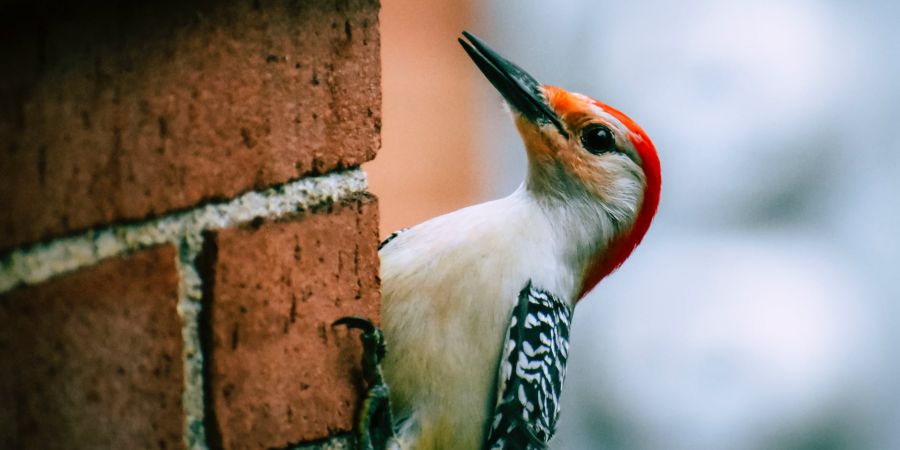

Woodpeckers are part of the bird familyPicidae, which also includes the piculets, wrynecks and sapsuckers.[1] Members of this family are found worldwide, except for Australia, New Guinea, New Zealand, Madagascar and the extreme polar regions. Most species live in forests or woodlandhabitats, although a few species are known that live in treeless areas, such as rocky hillsides and deserts, and the Gila woodpeckerspecialises in exploiting cacti.Members of this family are chiefly known for their characteristic behaviour. They mostly forage for insect prey on the trunks and branches of trees, and often communicate by drumming with their beaks, producing a reverberatory sound that can be heard at some distance. Some species vary their diet with fruits, birds' eggs, small animals, tree sap, human scraps, and carrion. They usually nest and roost in holes that they excavate in tree trunks, and their abandoned holes are of importance to other cavity-nesting birds. They sometimes come into conflict with humans when they make holes in buildings or feed on fruit crops, but perform a useful service by their removal of insect pests on trees.
The Picidae are one of nine living families in the order Piciformes, the others being barbets(comprising three families), toucans, toucan-barbets, and honeyguides, which (along with woodpeckers) comprise the clade Pici, and the jacamars and puffbirds in the clade Galbuli. DNA sequencing has confirmed the sister relationships of these two groups. The family Picidae includes about 240 species arranged in 35 genera. Almost 20 species are threatened with extinction due to loss of habitat or habitat fragmentation, with one, the Bermuda flicker, being extinct and a further two possibly beingMost woodpeckers spend their entire lives in trees, spiraling up the trunks in search of insects; only the few ground-feeding forms are capable of perching on horizontal branches, as passerine birds do. Most woodpeckers eat insects, but some (especially Melanerpes species) feed on fruits and berries, and sapsuckers regularly feed on sap from certain trees in some seasons. In spring the loud calls of woodpeckers, often augmented by drumming on hollow wood or occasionally on metal, are the sounds of males holding territories; at other seasons woodpeckers are usually silent. Most are not social, tending rather to be solitary or to travel in pairs.The acorn woodpecker (M. formicivorus) is about 20 cm (8 inches) long and is found from the deciduous woodlands of western North America south to Colombia. It depends on acorns for winter food, storing a supply in holes it drills in the bark of trees. The red-headed woodpecker (M. erythrocephalus) is roughly the same size (19–23 cm [7.5–9 inches]) as the acorn woodpecker, but it is sparsely distributed in open woodlands, farmland, and orchards of temperate North America east of the Rocky Mountains.The crimson-backed woodpecker (Chrysocolaptes lucidus) is common in open woodlands from India to the Philippine Islands. The green woodpecker (Picus viridis) ranges throughout the woodlands of temperate Eurasia and south to North Africa. The deciduous forests of the southeastern United States are the habitat of the red-bellied woodpecker (Centurus carolinus).
The ivory-billed woodpecker(Campephilus principalis), noted for its size (45 cm [18 inches] long) and beauty, was historically found in Cuba and the southern United States. Although listed as critically endangered, it was believed to be extinct. In 2005, however, researchers announced that the bird had been sighted in eastern Arkansas. A subspecies, the Cuban ivory-billed woodpecker (C. principalis bairdii), is thought to be extinct, and a related species, the imperial woodpecker (C. imperialis) of Mexico, is critically endangered and possibly extinct.Here we are covering fun facts about woodpeckers! There are over 210 different species of woodpeckers globally, and you can find them on every continent except Australia and Antarctica.
Woodpeckers are exciting creatures with some pretty extraordinary abilities! Keep reading to dive deep into fun facts about these fascinating birds! This article will discuss 17 facts about woodpeckers that you may not have known.
Most people think woodpeckers are just boring birds that peck on trees. Woodpeckers are unique and exciting birds. They have specially adapted bills and tongues which allow them to extract insects from tree bark.
With over 200 species, woodpeckers come in various shapes and sizes, and you will find them worldwide. A woodpecker plays an essential role in the ecosystem by helping to keep trees healthy by eating insects.
One of the most astonishing facts about woodpeckers is that there are none in Australia. The island of Australia does not have trees like cedar, oak, cypress, and fir. It’s these trees that help a woodpecker thrive and survive.
Australia’s most common trees are the Acacia estrophiolata, commonly known as ironwood. They are tough trees, often remarkable for making fenceposts but unsuitable for a woodpecker to forage for beetle larvae!
Woodpeckers eat a lot of insects and help control the population of insects in many regions. In places like Madagascar, where there are no insects, plenty of other animals fill the insect-eating gap. Madagascar has plenty of aye-aye’s, which eat beetle larvae and other insects by the thousands!
Woodpeckers can transfer the energy from the pecking and direct it into the rest of the body. This energy transfer happens because of the woodpecker’s unique skull anatomy.
When a woodpecker hits a tree, they turn the impact energy into strain energy in the bird’s body. But the woodpecker’s unique anatomy, including a specialized beak and skull, redirects most of the strain into the rest of the body. If there is too much strain on the head, it can be catastrophic.
Now, 99.7% of the strain energy is converted in the bird’s body, and only 0.3% is converted in the head. The bird will dissipate the small amount of strain from the head as heat. This process protects the bird’s brain.
However, because this process causes the temperature inside of the woodpecker’s head to rise, they usually take frequent breaks while pecking. Taking breaks allows the temperature inside of their head to lower.
Woodpeckers don’t get headaches, and it’s all thanks to their tongues and unique anatomy. Their unique skull anatomy will absorb and dissipate the shock of the repetitive pecking.
Not only does their anatomy help them to transfer the energy as we talked about above, but the tongue also cushions their brain. So yeah, this might be one of those fascinating facts about woodpeckers!
If you look at a woodpecker’s skull, you’ll notice that it’s unique in that its hyoid bone anchors the woodpecker’s tongue. The tongue is like no other animal in that it’s incredibly long and can wrap around the woodpecker’s skull.
When the woodpecker contracts the muscles surrounding the hyoid bone, it doesn’t just cause the woodpecker to stick out its tongue. That tensing-up action also helps tightly secure the skull and spine as the woodpecker’s beak collides with a tree. In the same fashion as a seat belt keeps you from flying forward if someone slams on the brakes.
That’s why woodpeckers don’t get headaches, even though they’re constantly banging their heads against trees!
Most people are familiar with the sound of a woodpecker pecking away at a tree. Many people don’t know that woodpeckers actually don’t peck at night.
Their bodies have a circadian rhythm that tells them to sleep at night and be active during the day. Depending on why they are pecking will determine the time of day. Usually, they will begin foraging for food at sunrise. At the same time, the early morning hours are also a great time to find insects to eat.
If they see another woodpecker near their territory, they may begin drumming. So next time you hear a woodpecker pecking away, remember that it’s probably during the daytime!
There are many different types of woodpeckers, but the Acorn woodpecker (a common is unique because it stores acorns in individual holes. This behavior, known as caching, helps the Acorn woodpecker survive the winter during food scarcity.
In the California Bay Area and the Pacific Northwest, acorn woodpeckers often store their acorns in granaries, trees with multiple holes drilled into them. Each acorn is carefully placed into a hole and then watched over by the communal woodpecker group. The Acorn woodpecker will often have several granaries containing a stash of acorns.
The woodpecker can fly to the granary and extract one from the hole when the acorns are needed. This intelligent behavior ensures that the acorn woodpecker always has a supply of food, even during tough times.


